Economic momentum still building
There has been quite a turn around in market sentiment with investors becoming cautious over fixed interest and getting ever more optimistic about equities. Harbour managers Andrew Bascand and Craig Stent explain what's happening.
Wednesday, October 9th 2013, 10:00AM
by Harbour Asset Management
Market highlights
- In September improving economic data and continued monetary easing from the US Fed boosted investor risk sentiment and equity market returns. On many measures equity risk appetite is stretched and some valuations could now be said to be expensive, although in our opinion not all valuation measures are currently fully stretched. Global equities rose +4.6% in the month, a result that could have been stronger as US budget issues hit returns on the last day of the period.
- The New Zealand equity market returned +4.3% in the month, positively led by global markets, by strong local data, and good results from smaller companies like Kathmandu and Synlait Milk. Cyclical stocks also performed strongly in the month.
- A soft GDP report in New Zealand for the second quarter disguised an underlying 2% lift in consumption and construction. The outlook is generally strong. Business confidence has hit levels not seen since 1999. Housing indicators are very robust, the terms of trade is improving, along with the external accounts. The Reserve Bank did its best to maintain a hawkish stance, providing forward guidance that OCR increases will be required “next year”.
- Fonterra lifted their forecast payout to $8.30 and, as a result, analysts have lowered profit forecasts for Fonterra Shareholders Fund units from 45 cents per share to around 32 cents per share for 2014. In contrast, Synlait exceeded prospectus forecasts and analysts lifted slightly their outlook for 2014.
- The Australian equity market rose 2.2% despite an initial positive impact from the election result, the market retained a cautious tone, with patchy data and company results. The utility, consumer staple and property sectors were weak, offsetting strong performances by industrial stocks. Seek continued its strong run up 12% in the month. Iron ore prices drifted lower, BHP lifted only 1.8%.
- In Australia, Oil Search announced their PNG LNG project was “progressing well and is 90% complete and on track to commence sales of LNG in 2014”. Building material and construction stocks performed strongly as signs of an improvement in the Australian building cycle continued. Lend Lease announced very strong pre-sales of their Bangaroo project.
Into self-sustaining growth territory in NZ
The US Institute of Supply Management manufacturing confidence index hit 56.2 for September, a further positive jump, leading global business confidence indices higher across the world. And while the markets entered September cautious about several risks, the discussion around Fed tapering was put to bed quickly as Ben Bernanke delayed the start date, perhaps influenced by concerns over the US fiscal debate, as much as the back-up in bond yields that has occurred in recent months.
Locally in New Zealand the ANZ business confidence survey reached 54.1, the highest level since 1999 and in our opinion is consistent with “self sustaining economic growth ”.
So it is not surprising that the RBNZ has started to talk-up the prospect of interest rate rises in 2014. First up the RBNZ may wait to see the impact of the introduction of macro-prudential tools to potentially cool parts of the housing market. However, it is hard to see that happening to any great extent given that the housing market is currently fuelled by credit led growth and so eventually rates will need to rise. Wheeler has said that “if the loan-to-value speed limit is unable to slow house-price inflation, larger increases in the official cash rate would be required. ”
Already the forward yield curve in New Zealand implies that the one-year interest rate will be 4% and that the 10 yr bond yield will be above 5% in a year’s time. As a result investors have anticipated higher interest rates and while rotation to equities and real assets might continue, the out-right valuation support for equities is waning. Nevertheless stronger economic growth, in the absence of inflation, still favours equities over bonds.
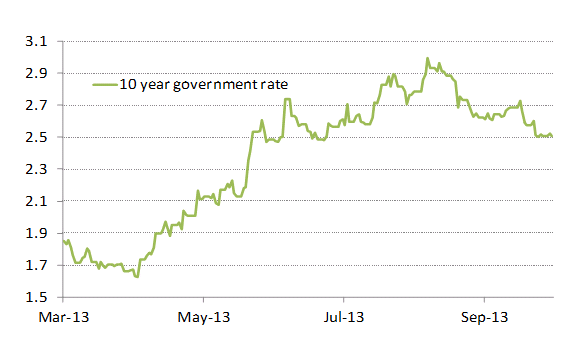
Source: Bloomberg
In conjunction with stronger business confidence, economic data continued to positively surprise in September across Europe, the US and China. In this light the US Fed’s decision not to taper was a surprise for markets that had set themselves up for a $5-$15bn reduction in the quantitative easing programme. More recent speeches from Fed Governors make it clear that this was a close decision and reflected an on balance assessment of the near term risks from the rise in bond yields, and from the potential reaction of the housing market. The US fiscal debate was another consideration.
Whatever the case, it is clear that markets read the decision not to taper positively with both equities and bonds rallying.
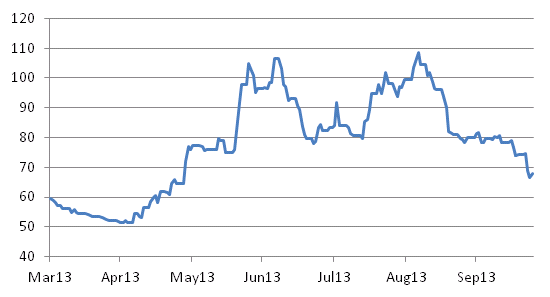
Source: Bllomberg
The Australian election may be a turning point
While elections themselves rarely impact markets, the potential for significant policy change in Australia may yet provide a better backdrop for Australian business and consumer confidence.
Last week we travelled to Australia and met with a number of companies to assess current conditions and their own reaction and perspectives on the election and the economic environment. There were several take-outs:
- Infrastructure spending at a State level is already rising and the new Federal government is placing significant pressure to get more projects underway.
- There is evidence of a pick-up in foreign investment interest – both institutional portfolio and private.
- Confidence in the housing market has clearly lifted, but remains limited by supply constraints, and hence house prices are moving up.
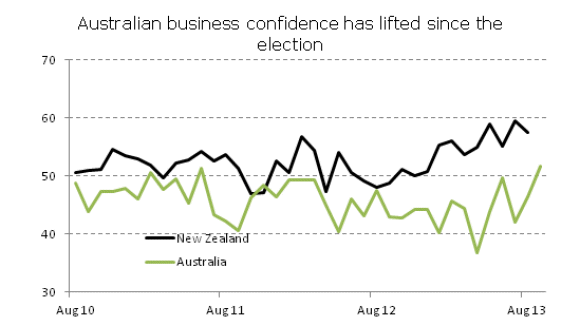
Bloomberg. Note PMI indices are used for comparative purposes. The NZ PMI differs from the ANZ NZ business confidence index, although the broad trends are similar
In addition to stronger Australian business confidence, there is evidence of a boost in Australian consumer confidence with the index rising to 110.6 (a 4.7% jump last month). However, retail sales remain sluggish, Australians continue to pay off their mortgages and increase savings. Over 80% of mortgages are ahead of their principal repayment schedule; on average by more than 7 months. Bank impairments on housing are at cyclical lows. CBA recently commented that their stock of houses in possession is at a multi-decade low at a value of less than 0.08% of their housing loan book.
A key issue for Australian companies is the lack of top line sales growth. In the last six months, sales revenue for the industrial sector grew by only 1.8%, margins expanded slightly but overall profit growth was also subdued. The key debate is whether top line growth can stretch higher, and whether margins can move towards cyclical highs as labour productivity growth improves.
In New Zealand the market is thinking about valuation
The New Zealand equity market is moving further toward over-valuation using earnings multiple measures. There are many ways to measure forward earnings multiples. For instance there is a range of PE estimates of between 15 and 18 times for the NZ market for the year ahead. Some 30 stocks, out of 58 for which data is available, trade at a forward PE multiple of over 15x .
For the NZ equity market, both the 5 year average and the long term average PE multiple is around 13.5x. On these measures some commentators say that the New Zealand market is now about 15% expensive relative to historical multiple averages. This analysis is superficial for a number of reasons.
- Historical comparative valuations assume that index constituents are similar or unchanged when in fact NZ equity market indices now differ significantly to those of 5 years ago.
- Interest rate, bond yields and inflation rates are strong influences on relative valuation. Absolute measures of valuation need to be adjusted for the financial economic cycle.
- The outlook for earnings growth, while partly captured by using 1 year forward looking valuations, is an influence as investors may change their perceptions of longer term corporate profit growth.
- Equity market volatility, and expected earnings and dividend volatility may also impact investor sentiment and hence equity risk premiums.
- Finally the period of history that we use to compare valuations today may not be comparable for all the above reasons. For instance it could be that history was wrong for New Zealand and the new normal is a NZ PE multiple closer to that of global counterparts. For instance the US equity market long term PE multiple is 16.2 times (the US trades currently on 16.9x) .
- Additionally, while the gap between equity and bond valuations has narrowed in many markets, the equity risk premium is still a little elevated. This continues to suggest a favouring of equities over bonds - providing earnings growth continues and inflation remains in check. But if we roll forward a year, implied fixed interest yields paint a more balanced picture between equities and bonds.
- Although it is again superficial to look at anyone indicator of “value”, a composite indicator that looks at a range of equity valuation measures suggests that the NZ equity market has clearly shifted from undervalued to overvalued, but in our opinion is not at a level that says the market is at an extreme level of valuation. Instead we can say that some indicators suggest a greater degree of caution, while others are more supportive. A composite of a number of valuation measures is shown in the following chart.

Source: UBS, Forsyth Barr, Bloomberg, Harbour estimates. Measures are standardised using a Z-Score of averages and standard deviations for the full period. No back test has been conducted, and Harbour does not warrant the efficacy of this indicator.
Some excellent results: Kathmandu
A little over a year ago we established a position in Kathmandu. The stock price has performed strongly in part because the company has significant tail winds from demographic trends . Travel and leisure spending is increasing as a proportion of household expenditures.
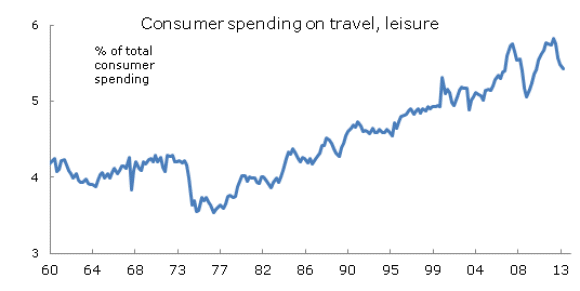
Source: Deutsche Bank
And market expectations for Kathmandu’s earnings have picked up significantly in the last year, in part associated with stronger Australian consumer confidence.
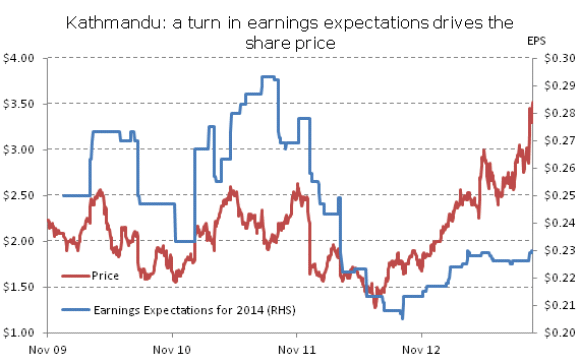
Source: Bloomberg
Australian Consumer Confidence
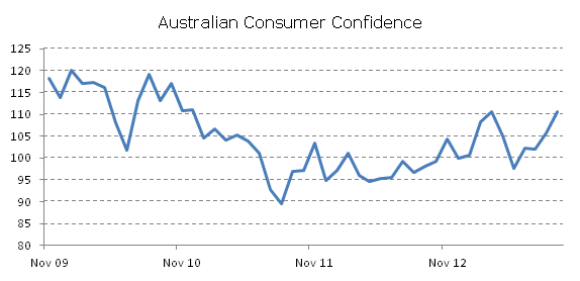
Source: Bloomberg, Westpac
Tensions in the outlook
Investors are still adjusting to the negative returns received from government bonds in the last 6 months. Sentiment in the bond market is poor, although not as bad as at the end of August. And yet this adjustment in the New Zealand yield curve already implies significantly higher interest rates in future years. A significant amount of the potential policy tightening has been built into the yield curve and hence potential yields from NZ fixed income have increased. Nevertheless investors remain cautious about fixed interest.
In contrast equity sentiment remains buoyant and in some markets could be said to be excessive. New Zealand valuations have moved higher. On some measures the equity market could be said to be expensive, although on a composite basis it is hard to draw strong conclusions. Perhaps the strongest point at this conjuncture is the obvious point, that the rise in bond yields and rise in the equity market has lessened substantially the previous significant attractiveness of NZ equities relative to NZ bonds.
For now strong momentum in the New Zealand economy ought to mean better corporate profits. It also means that the RBNZ is closer to pulling the trigger on a rise in interest rates and this tension will begin to play out in the next six months.
Important disclaimer information
| « The Federal Reserve recants | Hamish Douglass Unplugged - Latest Video from Adviser Briefing - August 2012 » |
Special Offers
Comments from our readers
No comments yet
Sign In to add your comment
| Printable version | Email to a friend |









